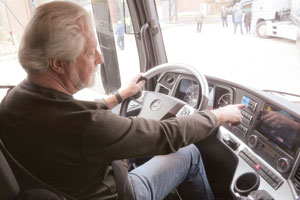Behind the Wheel of a Self-Driving Truck

This story appears in the July 11 print edition of iTECH, a supplement to Transport Topics.
Being one of the few CDL holders with an autonomous endorsement to drive a truck with “self-driving” capabilities is a dubious claim to fame. But there it is. And why, if the truck drives itself, is there a need for a credential?
There are few places in the world where autonomous trucks are allowed on public roadways. One jurisdiction is in Nevada, but it has a caveat to that permission: You must have completed a course structured by Daimler Trucks — to date the leader in creating, developing and producing autonomous trucks — to train drivers what to expect and how to perform in piloting the current pair of Freightliner Inspiration trucks.
Another is the state of Baden-Württemberg in Germany, with its capital, Stuttgart, the home of Daimler AG.
Daimler first demonstrated autonomous truck-driving technology back in the summer of 2014 on an Mercedes-Benz Actros on a closed-off stretch of the autobahn near Magdeburg, Germany.
CHAT WITH SETH: TT Technology Editor Seth Clevenger takes your questions, noon EDT, July 18
BEST OF JULY iTECH: More stories, columns
That was not a driving experience but more of a “wow” demonstration to see and understand that technology had advanced to the point where a heavy truck could interact safely — more safely than trucks with human drivers — with the environment and other traffic.
After the initial revelation and reveal of the autonomous Actros, some said: “OK, but so what? You still need a driver in the truck.” The rules in Germany demanded it.
Then, with the much more recent demonstration in March of platooning with three autonomous trucks, each electronically tethered to the others, it all began to make more sense. There are some very real cost and safety savings to such a platoon going along the highways, whether they are German autobahns or American freeways. In fact, the long, straight and often nearly deserted highways of North America make the technology even more relevant.
That’s why Daimler demonstrated the technology with a couple of Freightliner trucks in the most spectacular truck launch in memory at the Hoover Dam in May 2015. That was the nondriving launch for the North American media. And then a few select CDL journalists got to drive those Freightliners in September.
There’s not a lot to it, of course. I mean if it’s an autonomous truck, how difficult can it be to drive? There are switch sequences to learn, screens to view, warning lights to interpret. But for me, the big step was releasing the steering wheel and letting the truck take over. That, watching over the controls and reverting to driver control when required, is all the driver has to do in the autonomous truck.
The experience took me back maybe 20 years. I used to do a presentation on upcoming truck technology and closed with the prediction that the truck cabs of the future would feature a computer, a driver and a dog. The computer was there to drive the truck. The man was there to make sure the computer didn’t do anything wrong. The dog was there to bite the driver if he interfered with the computer.
 WatchCartoonsOnline.eu
WatchCartoonsOnline.eu And there’s a memorable “Simpsons” episode that features Homer Simpson as a stand-in truck driver. Inevitably, Homer falls asleep going down a mountain pass, yet the truck takes over the driving task, keeping Homer and Bart safe till it comes to a stop at a truck stop. The secret system on Homer’s and, as it turns out, other trucks is the Navitron Autodrive. For more, you can search “Maximum Homerdrive.”
Much of the technology that enables the autonomous trucks is already available on trucks today. The intelligent cruise that sets following distances to other vehicles has been available for at least five years. Safety-conscious fleets are spec’ing lane warning/keeping. High-end cars already have steering assist tied in to lane keeping so inattentive drivers stay in their lane. Stability systems prevent truck rollovers and slam on the brakes if there’s something in the path of the vehicle.
What more do you need? Answer: Nothing. Just a controller to interpret all the inputs, calculate then execute. And based on my experience driving the Freightliner Inspiration truck in Nevada, when control has been relinquished to the truck, there’s not much to do. Which form of truck automation would you most readily embrace?
In the Nevada certification, we drove the trucks around a loop on a public highway and freeway, letting the truck handle the relatively straight-line work, while we drivers took over control for maneuvering around corners and driving the surface streets around the Las Vegas Speedway. And I have to say, the Inspiration truck did a marvelous job.
The Inspiration trucks not only have self-guidance, they also have rearview camera systems that display the images on interior screens. These images are dynamic, so that as the truck maneuvers around sharp corners, the image adjusts so the back of the trailer and the tandem are always in view. While driving, I had to master this new rearview system and also be prepared to let go of the steering wheel as the system took control of the truck.
The only odd thing about this is that as the Highway Pilot system takes over the steering, the driver has to consciously let go of the steering wheel — somewhat unnerving as the feeling at the wheel is rather akin to the truck running on a rutted road or hitting a pothole — a situation where the driver would normally tighten the grip on the wheel.
But there was no drama associated with the driving — or rather sitting in the driver’s seat. It is all very seamless, and there are overrides to allow the driver to quickly take over if the need arises.
The system is activated by a red switch in the entirely remodeled dash of the Inspiration truck. The all-electronic display ahead of the driver has information and prompts, changing its appearance when the Highway Pilot is engaged.
Driving with the system disengaged, the Inspiration truck is no different than the Cascadia Evolution upon which it is based.
On the road, the system takes a few hundred yards to zero in on the road markings then displays a message that Highway Pilot is available. At this point, hitting the “resume” button on the steering wheel-mounted cruise controls enables the system, and it takes over steering, cruise control and following distance to the vehicle in front. It also has automated braking to avoid collisions.
While it is engaged, the driver can take over the wheel at any time for, say, a lane change without disabling the system. But a touch on the brake pedal or a push on the cruise “off” button immediately disengages it.
Daimler talks about freeing the driver from the task of controlling the truck to do other things while observing the autonomously driving truck — so far no one has suggested eliminating the driver altogether. But that is not beyond the realm of possibility when you consider the use of autonomous trucks in convoy in a platoon.
In a platoon, a lead truck with its driver is tethered to other trucks via an electronic drawbar. The trucks close up to a nominal and very short separation and enjoy the fuel savings of drafting the lead vehicle.
But most likely is that autonomous trucks with drivers overseeing the controls will make their appearance sooner than the self-driving Google cars. And that’s not so unreasonable. When you’re sitting in an airplane at 35,000 feet heading for your destination — as I am today, writing this piece — the pilot is not driving the plane. It flies itself. And, in dismally poor visibility, it actually lands itself, doing a far better job than the pilot ever could. If we can accept that, how can we deny an autonomous commercial vehicle or car?
Daimler’s plan is to involve the driver in more of the freight-management side of trucking — handling business decisions instead of handling the steering wheel. For an owner-operator of a small fleet, I can see that as a big plus: negotiating freight rates, dispatching other trucks under his or her control, handling claims or other billing issues while keeping one eye on the road ahead. But for your average company driver, it more likely means looking out of the windows as the scenery flows by.
Speaking as a licensed driver of self-driving trucks, that sounds like not a bad place to be. It could be possible to pound out a story while going down the road. Maybe it’s time for a career modification.

